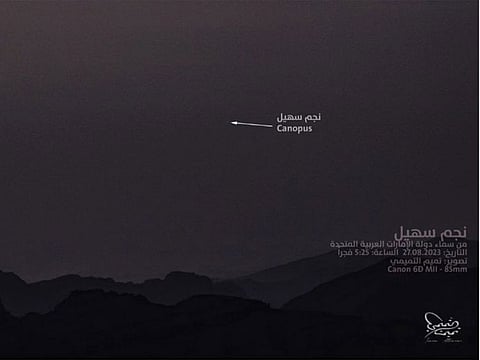Cooler weather in October, winter in December, explains UAE astronomer
Winter begins ‘100 days after the rise of the Suhail star’, says Ibrahim Al Jarwan

Dubai: On August 27, the Suhail star was spotted rising in the UAE. In Arabian culture, the rising of Suhail typically marks the end of the intense summer heat.
But temperatures in the UAE are still quite high. So when does winter really begin?
Ibrahim Al Jarwan, Chairman of the Emirates Astronomy Society took to Instagram to explain that while the rising of the Suhail star signals the approach of more moderate temperatures, winter comes only around 100 days later.
“The Arabs consider the rise [of the Suhail star] as the sign of a break in the heat intensity and an increase in the flow of moisture (humidity), the redness (heat) of the Earth and the soil begins to cool at dawn, and the morning fog forms. Humid winds of moderate temperature blow across the country,” he wrote in the caption, along with the photo of the Suhail star, also called Canopus.
Over the next 40 days, there will be a slight yet noticeable decline in heat and an increase in humidity, he further explained.
“Then the atmosphere settles down towards a season of moderate heat that begins 60 days after the rise of the Suhail star. By mid-October and the cold of dawn begins. As the real cold weather gradually sets in, winter begins in early December, 100 days after the rise of Suhail.”
In a previous Gulf News story, a National Center of Meteorology expert explained that when humidity levels rise, the heat index or the “feeling temperature” can also be high.
“Whenever the Relative Humidity (RH) increases, the ‘feeling temperature’ seems higher. The ratio of RH is important in calculating the comfort index, or the temperature felt by the human body when outdoors. For example, if the official temperature reading is 40°C and the RH is 20 per cent, outdoor temperature will feel 40°C. However, if RH is 65 or 75 per cent, the outdoor temperature will feel like 45°C or more,” he said.
The NCM expert added that the heat index also changes depending on other factors, such as wind speed and air mist. He explained that on days when temperatures are high but the weather is windy, it might not feel as hot.
Sign up for the Daily Briefing
Get the latest news and updates straight to your inbox






_resources1_16a4a15f062_large.jpg?w=320&auto=format%2Ccompress&fit=max)
